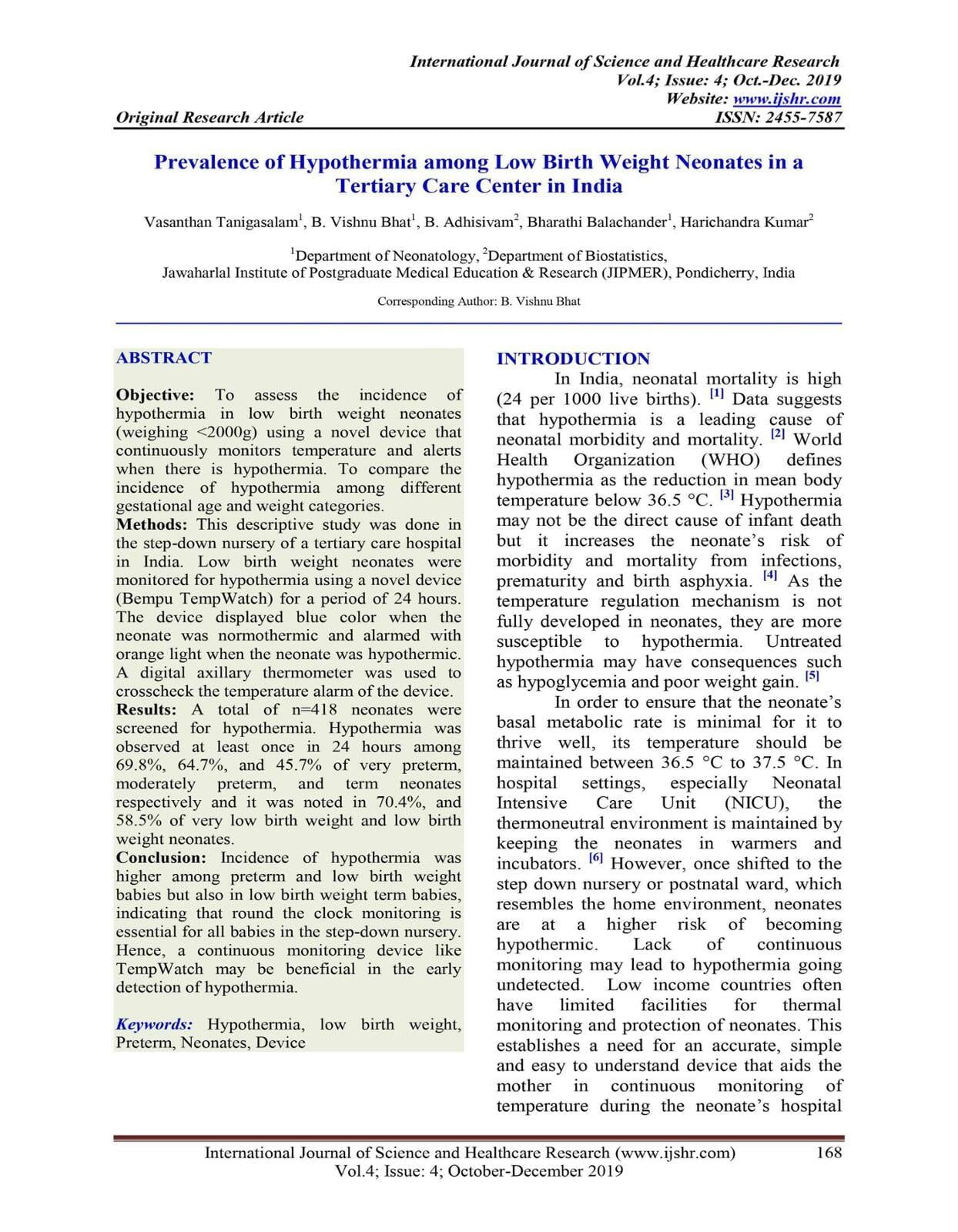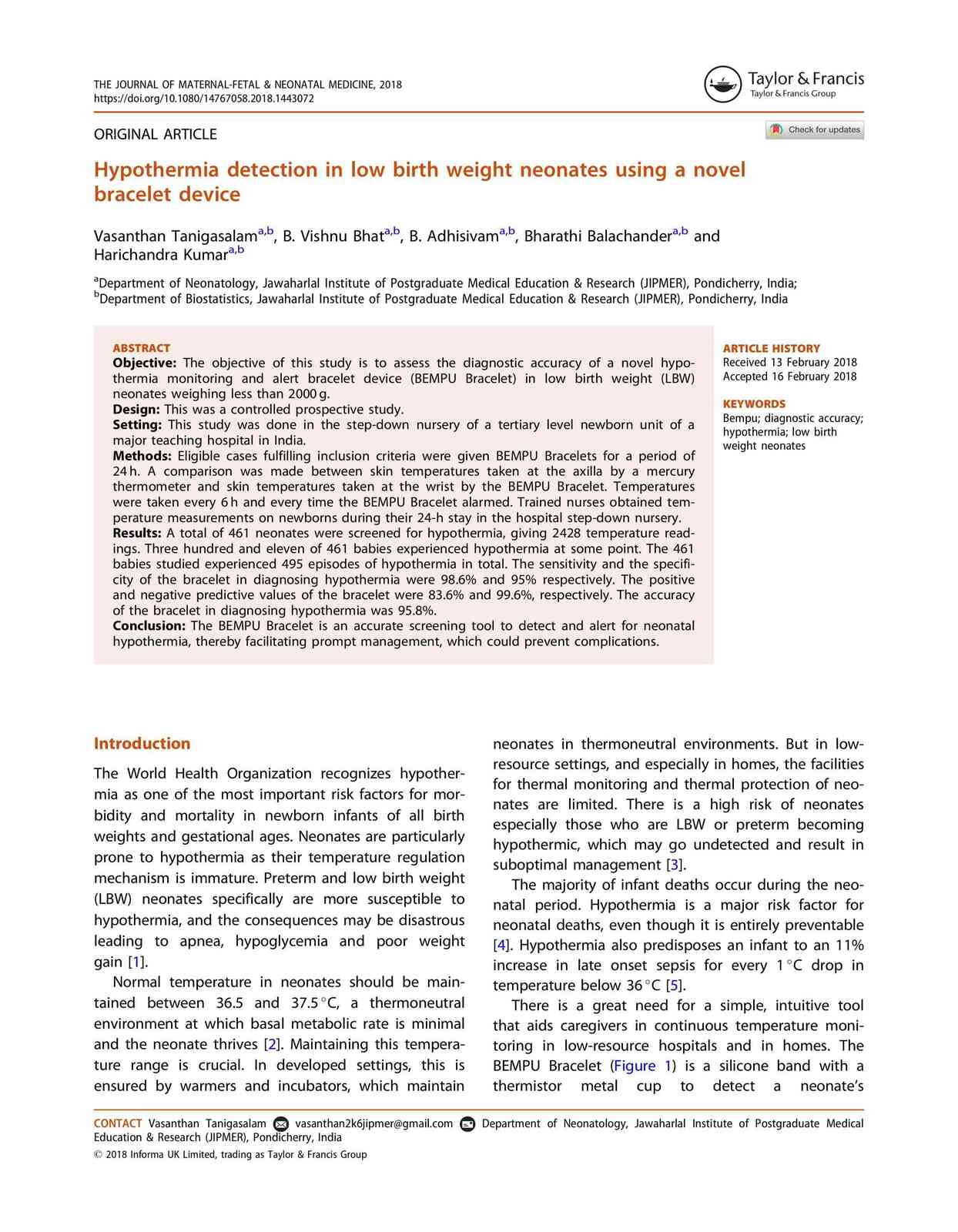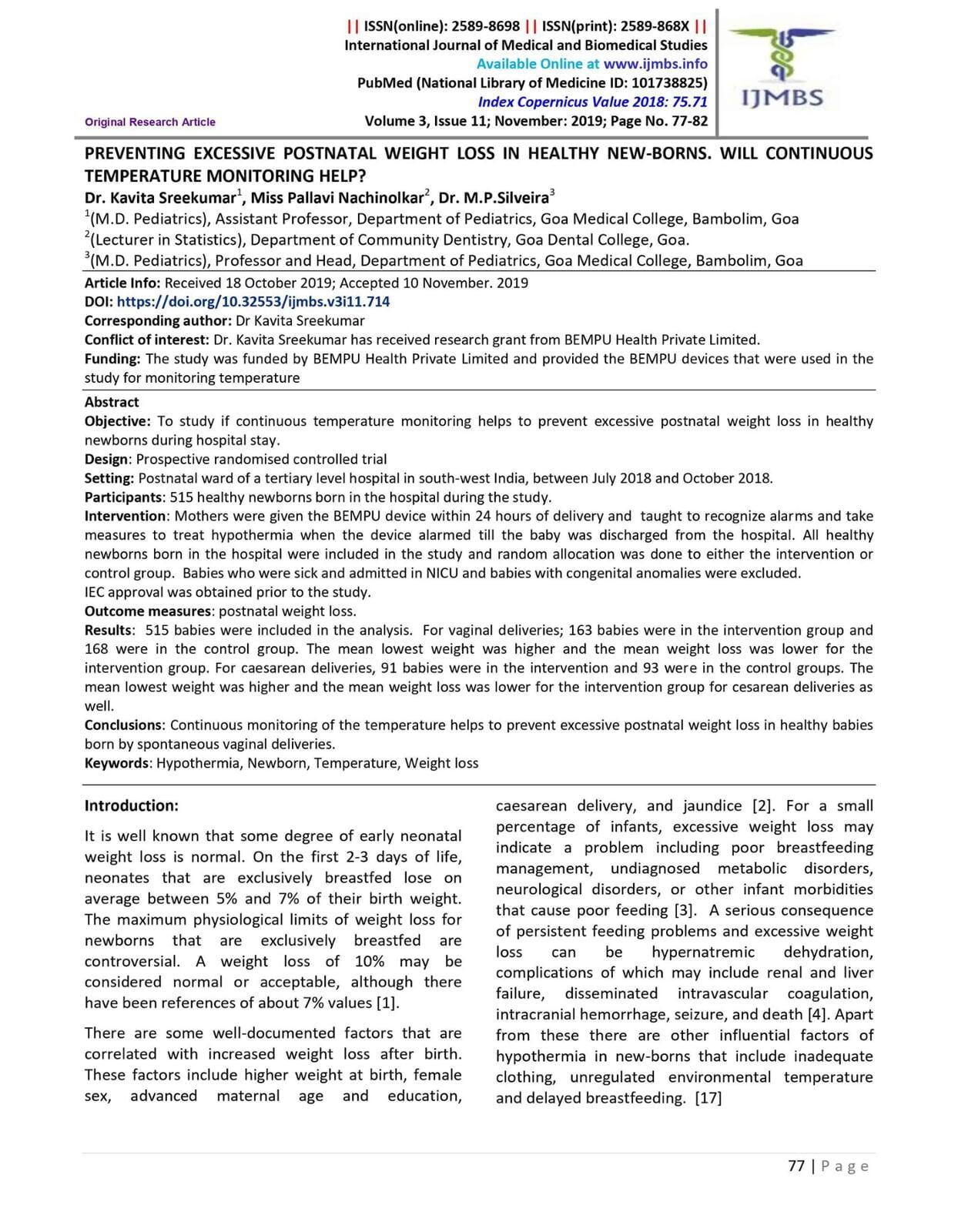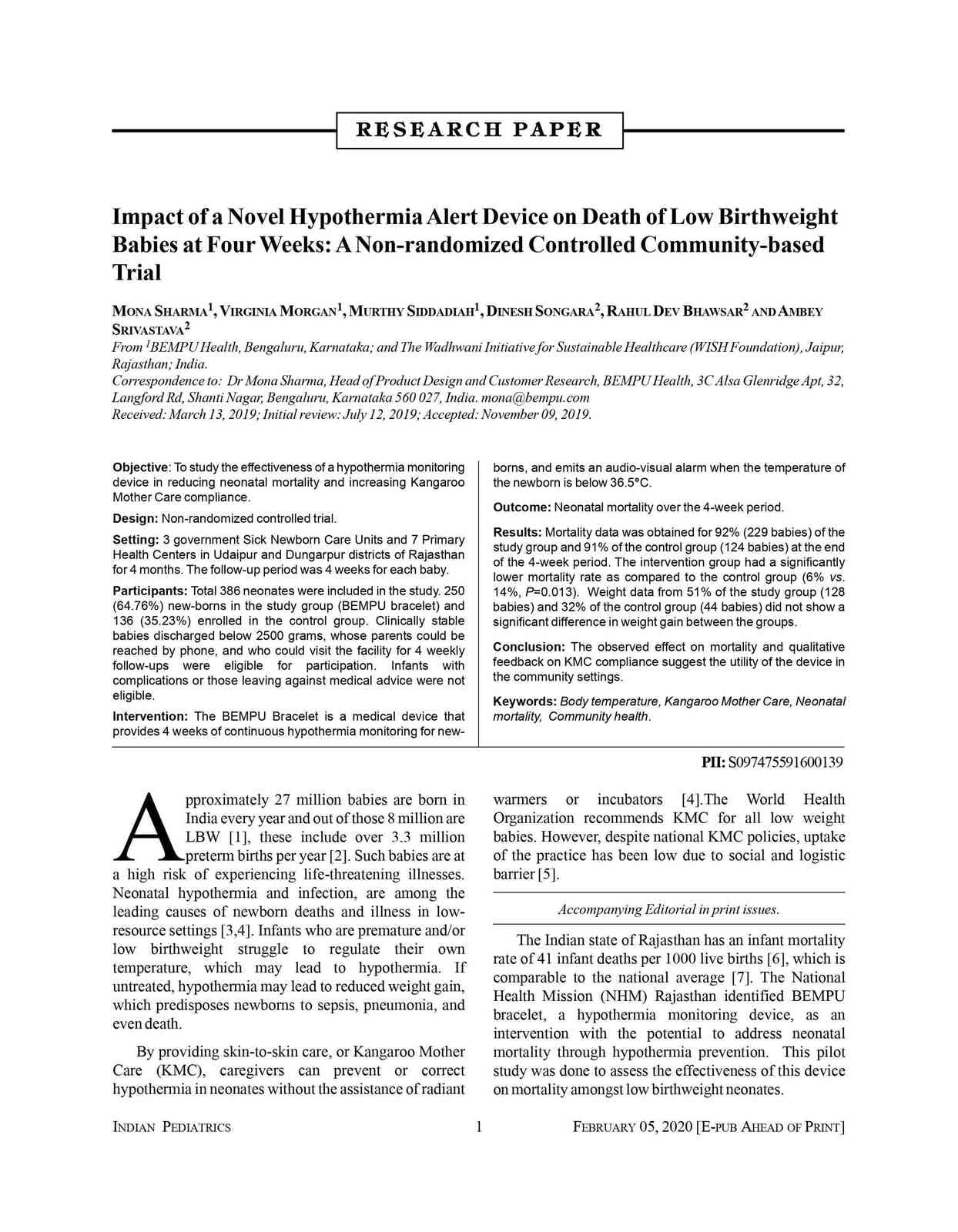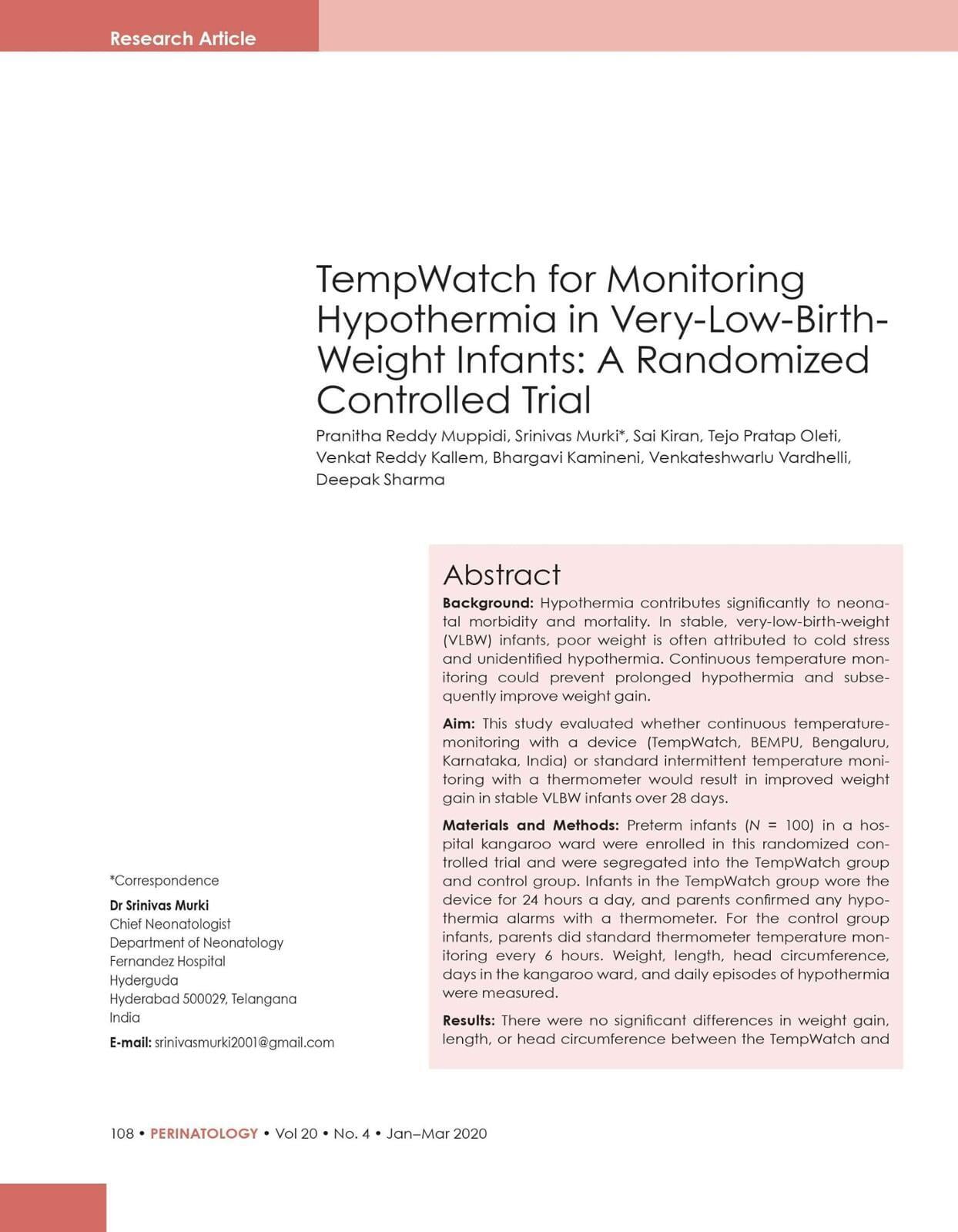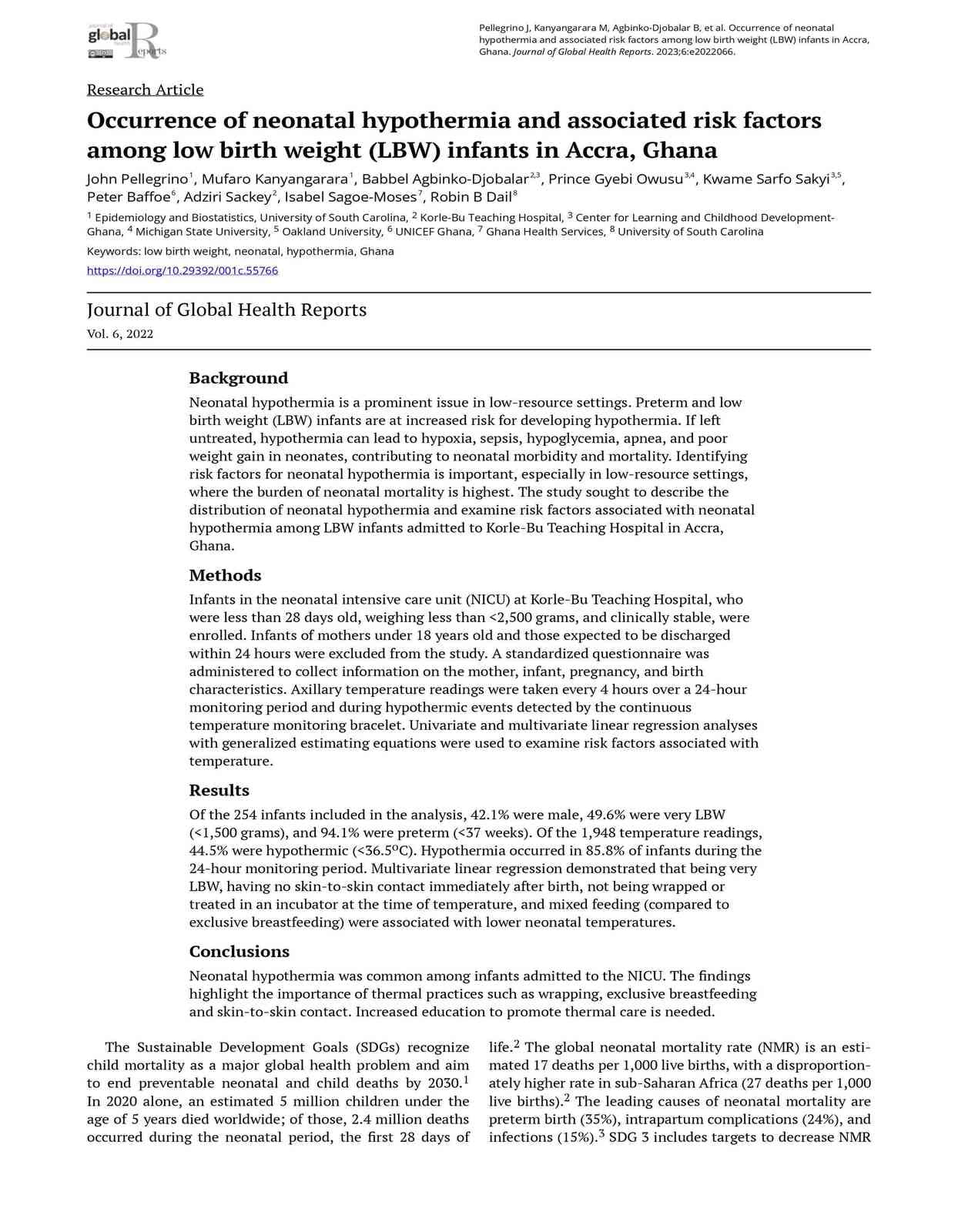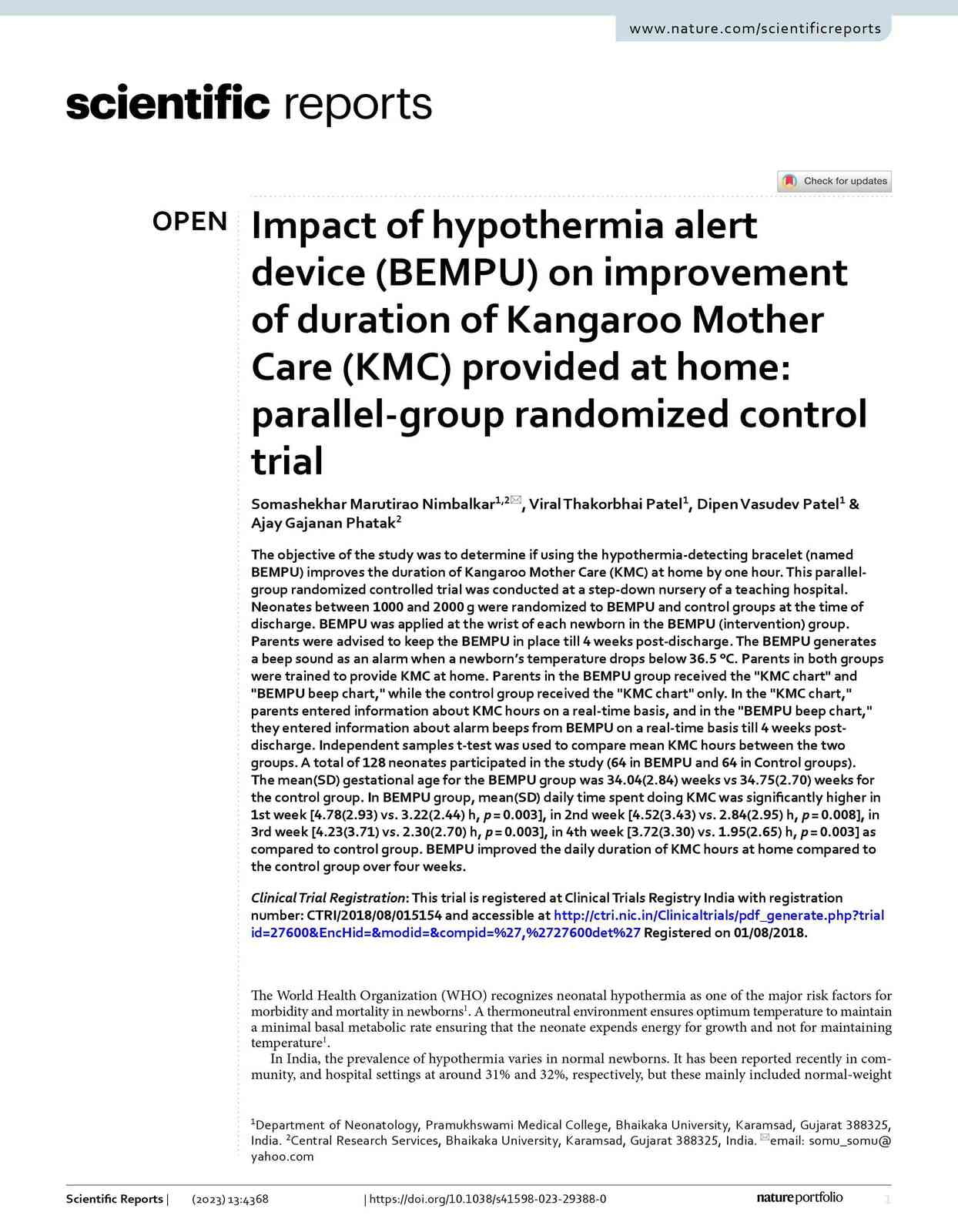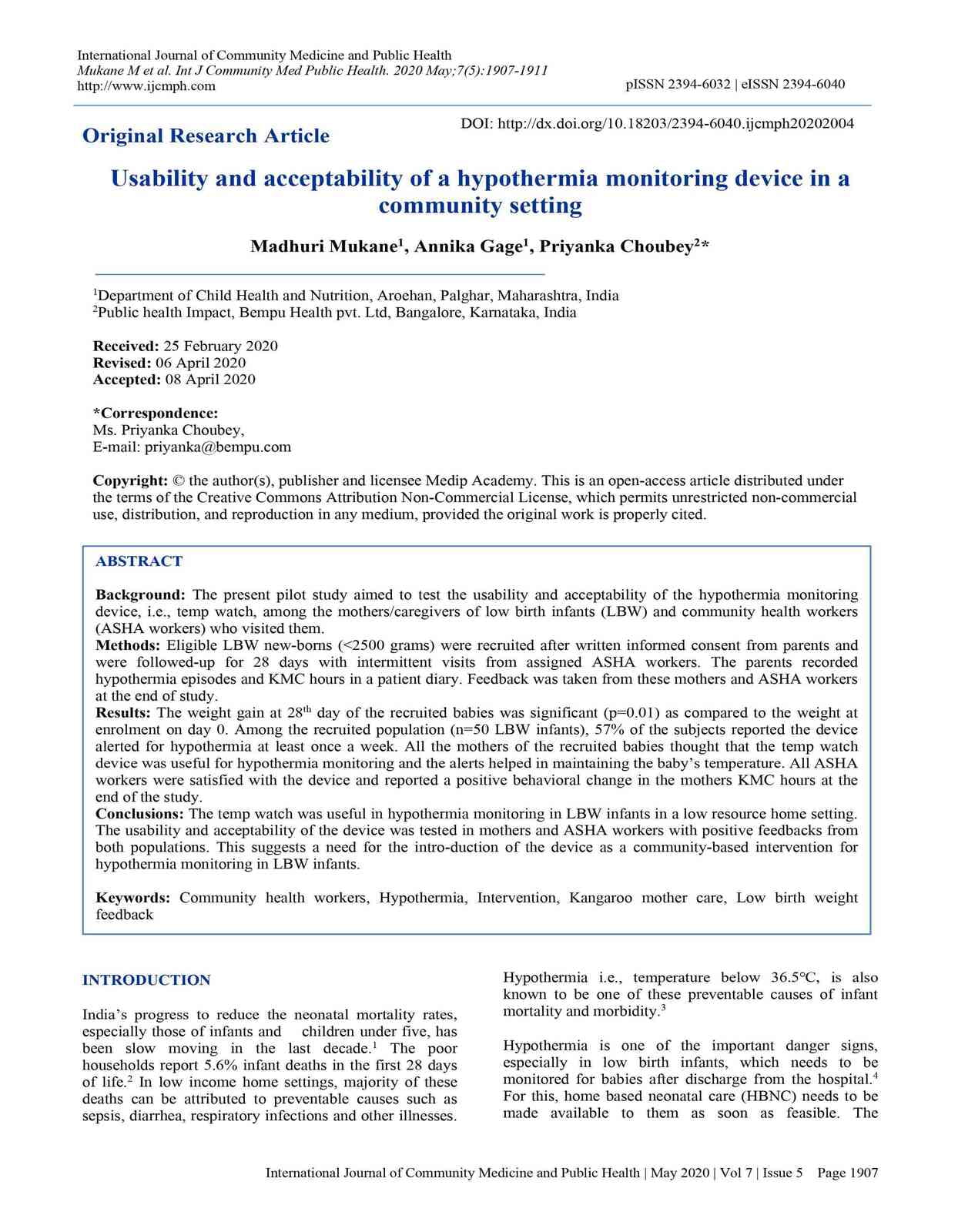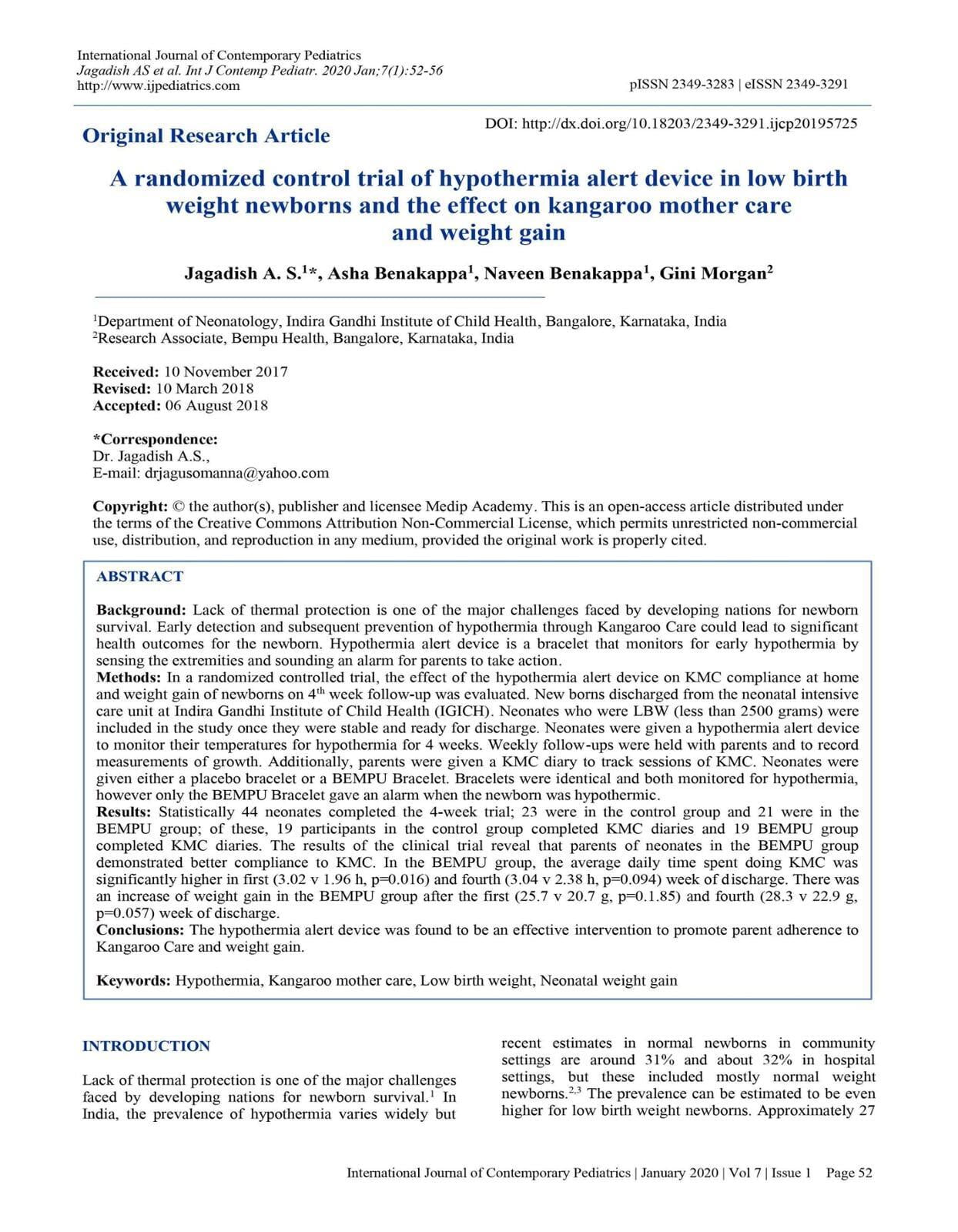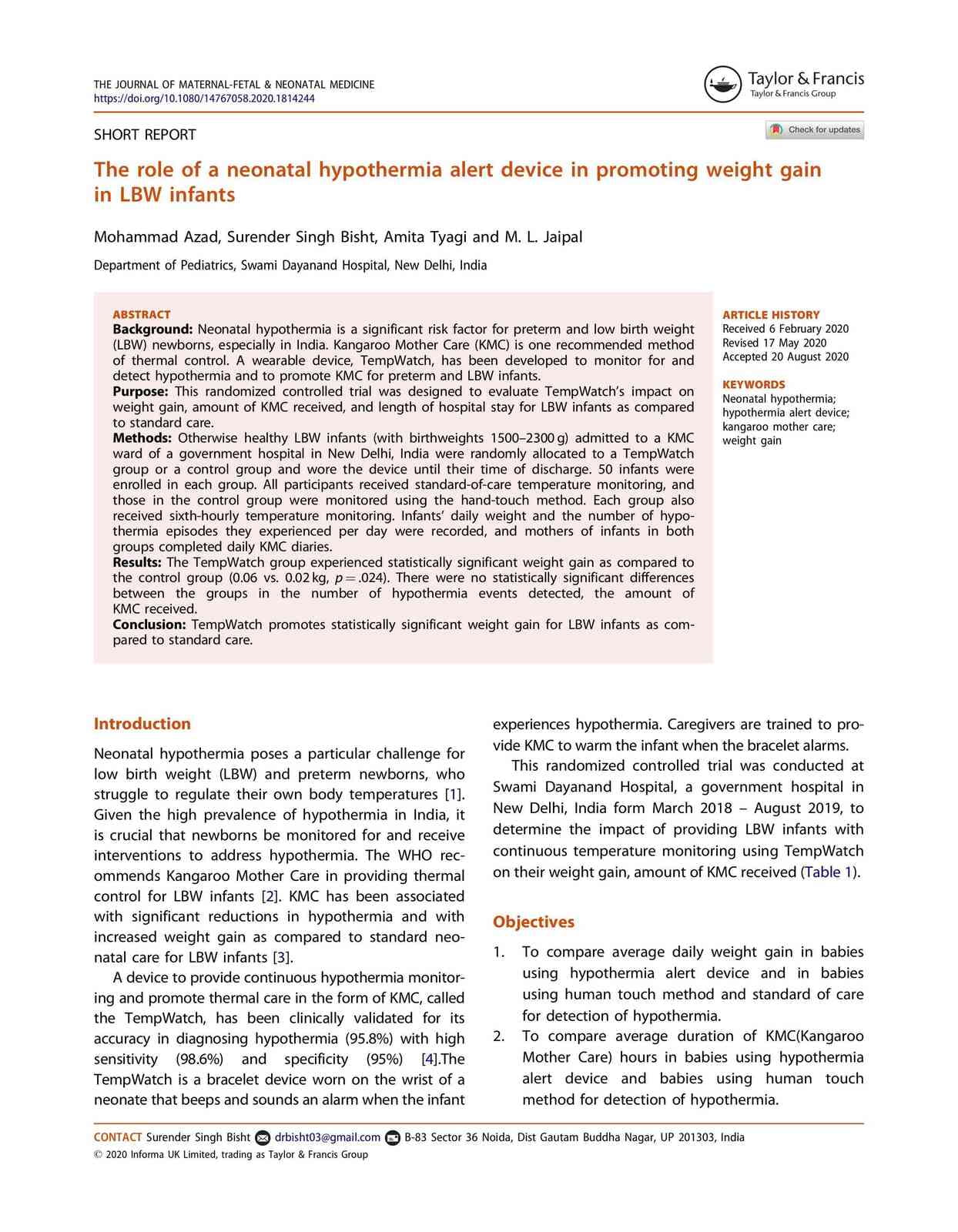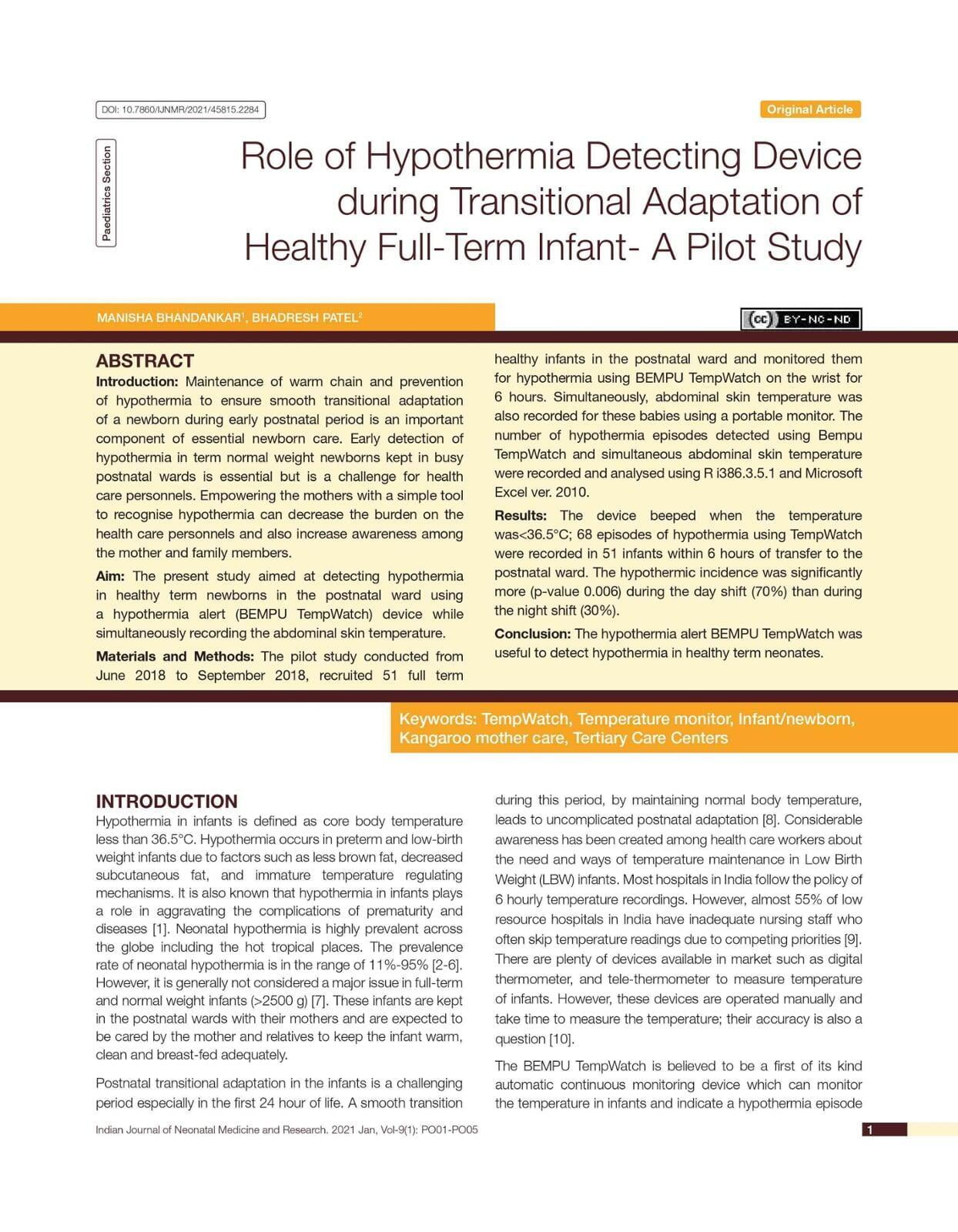TempWatch Evaluations
The TempWatch has been evaluated in 11 publications, 2 UNICEF pilot evaluations, 1 US CDC evaluation and additional evaluations are ongoing. Copies of our clinical papers can be found here and summaries of the findings are below. If you are researching or evaluating BEMPU products, we would appreciate if you could contact us at hello@bempu.com or on WhatsApp at +91-94818-41872 so we have the opportunity to share the latest research findings with you. Please note that our product pricing for LMIC and public health procurement (UNICEF, WHO, Governments, Foundations, etc) is significantly lower than our price to high-income individuals purchasing through Amazon or our website.
Finding 1: TempWatch Accuracy
- Accuracy
A 2500 reading study found the device to have a 99% sensitivity, 95% specificity, 83% positive predictive value, and 99.6% negative predictive value [1]. - Identifying a High Incidence of Hypothermia
JIPMER Pondicherry found the TempWatch detected hypothermia in 65% of 418 babies < 2kgs within the first 24 of birth [2]. Another study at KLE Belgaum found the TempWatch detected hypothermia in 96% of term babies within the first 6 hours of transitory care [3]. A study by University of South Carolina in partnership with UNICEF Ghana used the TempWatch to identify hypothermia in 86% of newborns [12]. 75% of mothers using the TempWatch at home received alerts during a UNICEF Benin implementation project.
Finding 2: Response from Users
- With Health Care Workers
100% of 40 community health workers (ASHAs) in a Maharashtra study found the device useful [8]. The US CDC reported significant aspects of feedback and observations from village health care workers implementing the TempWatch [10]. - With Mothers
100% of 43 mothers in a Hyderabad study found the TempWatch useful in detecting low temperature [6].
Finding 3: Supports Healthy Behaviour Change
- Kangaroo Care - Nimbalker et al’s RCT found babies with the Tempwatch received over 50% more KMC than those without [14]. The US CDC found mothers in Papua New Guinea did significantly more instances of Kangaroo Care with the TempWatch than those without [10]. A Bangalore RCT found mothers using the Tempwatch did 3 hours of kangaroo care vs 2 hours for those without during the first week [3].
- Knowledge, Attitude, Practice - The US CDC found "knowledge, attitude and practices concerning the prevention and management of hypothermia among the non device users were found to be relatively lower or less accurate than the users" [10].
Finding 4: Improved Clinical Outcomes
- Increased weight gain - The US CDC found babies wearing the TempWatch gained more weight vs the controls [10]. A Bangalore RCT found babies using the Tempwatch gained 28 grams per day vs 23 in the control over 4 weeks [3]. A Delhi RCT found babies had statistically significant weight gain during their hospital stay [11]. A Hyderabad RCT did not find a difference in weight gain between the two groups [7].
- Decreased excessive weight loss - A Goa study with 515 babies found a significant reduction in excessive weight loss for newborns wearing the TempWatch vs control [5]
- Potential for Decreased Mortality - A nonrandomized controlled trial in Rajasthan government hospitals with 386 newborns found a 4 week post-discharge mortality rate of 6% vs 14% in the BEMPU vs control group [4]
Additional Non Clinical Reviewed Evaluations
- Implementation Information - Additional implementation experience can be observed in the extensive US CDC report for UNICEF Papua New Guinea, the deployment report from UNICEF Benin and the pilot evaluation report from UNICEF Pakistan available here.
- Cost Effectiveness - A 2019 Duke University analysis found the TempWatch to be very cost-effective with at $746 per life saved and $25 cost per life-year extended. Since this study, the price of the product has been significantly reduced and long-lasting reusable models have been introduced.
References
Copies of our clinical papers can be found here. Please contact us at hello@bempu.com or on WhatsApp at +91-94818-41872 for more information.
- Tanigasalam et al., 2019. Hypothermia detection in low birth weight neonates using a novel bracelet device. Available at; https://www.ncbi.nlm.nih.gov/pubmed/29463144
- Tanigasalam et al., 2019. Prevalence of Hypothermia among Low Birth Weight Neonates in a Tertiary Care Center in India. Available at; https://www.gkpublication.in/IJSHR_Vol.4_Issue.4_Oct2019/IJSHR0027.pdf
- Jagdish et al., 2019. A randomized control trial of hypothermia alert device in low birth weight newborns and the effect on kangaroo mother care and weight gain. Available at; https://www.ijpediatrics.com/index.php/ijcp/article/view/1205
- Sharma et al., 2020. Impact of a Novel Hypothermia Alert Device on Death of Low Birthweight Babies at Four Weeks: A Non-randomized Controlled Community-based Trial. Available at; https://www.ncbi.nlm.nih.gov/pubmed/32038035
- Sreekumar et al., 2019. Preventing excessive postnatal weight loss in healthy newborns. Will continuous temperature monitoring help? Available at; https://www.ijmbs.info/index.php/ijmbs/article/view/714
- Reddy et al., 2019. Neonatal Hypothermia Monitoring and Alerting Device, Acceptability among Mothers and Caregivers. Available at; https://www.ijrrjournal.com/IJRR_Vol.6_Issue.12_Dec2019/IJRR0030.pdf
- Reddy et al., 2020. TempWatch for Monitoring Hypothermia in Very-Low-Birth-Weight Infants: A Randomized Controlled Trial. Available at; https://www.perinatology.in/tempwatch-for-monitoring-hypothermia-in-verylowbirthweight-infants-a-randomized-controlled-trial
- Mukane et al., Usability and acceptability of a hypothermia monitoring device in a community setting. Available at International Journal of Community Medicine and Public Health https://www.ijcmph.com/index.php/ijcmph/article/view/6226
- US CDC & UNICEF, PNG Evaluation Report https://www.unicef.org/evaldatabase/files/Final_Kol_Kilok_Evaluation_Report_PNG.pdf
- Manisha Bhandankar ,http://www.ijnmr.net/articles/PDF/2284/45815_CE[Ra]_F(Sh)_PF1(AKA_KM)_PFA(SHU_AKA)_PN(SHU).pdf
- Mohammad Azad , Surender Singh Bisht , Amita Tyagi & M. L. Jaipal (2020): The role of a neonatal hypothermia alert device in promoting weight gain in LBW infants, The Journal of Maternal-Fetal & Neonatal Medicine, DOI: 10.1080/14767058.2020.1814244
- Pellegrino J, Kanyangarara M, Agbinko-Djobalar B, et al. Occurrence of neonatal hypothermia and associated risk factors among low birth weight (LBW) infants in Accra, Ghana. Journal of Global Health Reports. 2023;6:e2022066. https://www.joghr.org/article/55766-occurrence-of-neonatal-hypothermia-and-associated-risk-factors-among-low-birth-weight-lbw-infants-in-accra-ghana
- Soliou B (UNICEF Benin), Guezo-Mevo B. Real-time monitoring, technological innovations and improving the quality of maternal and neonatal care: Benin's experience. April 2019.
- Nimbalkar, S.M., Patel, V.T., Patel, D.V. et al. Impact of hypothermia alert device (BEMPU) on improvement of duration of Kangaroo Mother Care (KMC) provided at home: parallel-group randomized control trial. Sci Rep 13, 4368 (2023). https://doi.org/10.1038/s41598-023-29388-0

